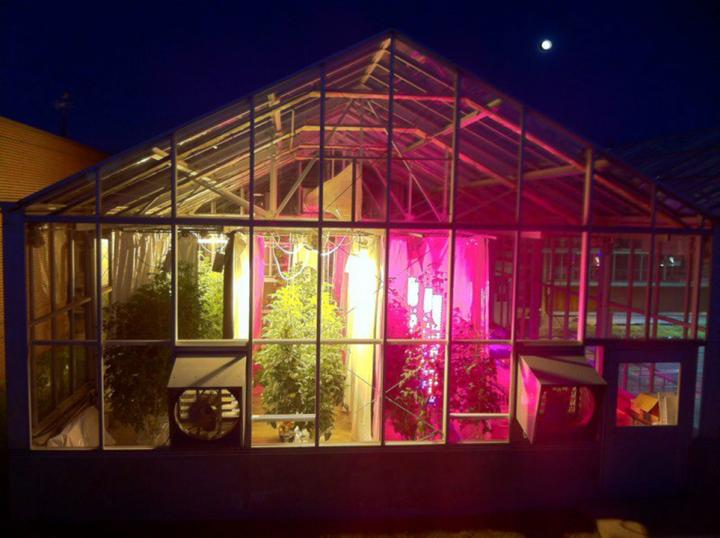How LED lighting treatments affect greenhouse tomato quality

Tomato plants received supplemental lighting from high-pressure sodium lamps or from intracanopy (IC) LED towers. Results showed that tomato quality was largely unaffected by the type of light treatment. Photo courtesy of Michael Dzakovich
To satisfy increasing consumer demand for locally grown, fresh tomatoes during off-seasons, greenhouse tomato growers often need to rely on supplemental lighting.
Tomato growers are looking to light-emitting diodes (LEDs), favored for their energy-saving potential, as an alternative to high-pressure sodium lamps (HPS) in greenhouse operations. A recent study offers new information about the feasibility of using LEDs in greenhouse tomato operations.
Michael Dzakovich, Celina Gómez, and Cary Mitchell from the Department of Horticulture and Landscape Architecture at Purdue University published the study of supplemental lighting experiments in HortScience (October 2015). They noted that light-emitting diodes are becoming a viable alternative to high-pressure sodium supplementation.
“There is great interest in (LEDs) potential to influence the phytochemical and flavor profile of various high-value crops,” the authors said. “However, little fruit quality-attribute work with LEDs has been done on a long-duration, full grow-out of tomatoes.”
The researchers conducted three separate studies to investigate the effect of supplemental light quantity and quality on greenhouse-grown tomatoes. Plants were grown either with natural solar radiation only (the control), natural solar radiation plus supplemental lighting from high-pressure sodium lamps, or natural solar radiation plus supplemental light from intracanopy (IC) LED towers.
The scientists analyzed plant responses by collecting chromacity, Brix, titratable acidity, electrical conductivity, and pH measurements. “Contrary to our hypothesis, fruit quality was largely unaffected by direct, IC supplemental lighting,” the authors said.
The study also included sensory panels in which tasters ranked tomatoes for color, acidity, and sweetness using an objective scale. The tasters were also asked to rank tomato color, aroma, texture, sweetness, acidity, aftertaste, and overall approval using a five-point hedonic (preference) scale.
“By collecting both physicochemical and sensory data, we were able to determine whether statistically significant physicochemical parameters of tomato fruit also reflected consumer perception of fruit quality,” the authors said. The sensory panels indicated that physicochemical differences were not noticeable to tasters; in fact, the tasters on the testing panels could not discern between tomatoes from different supplemental lighting treatments or those from the unsupplemented controls.
“This study demonstrated that greenhouse tomato fruit quality was unaffected by both the type of supplemental lighting as well as supplemental lighting per se,” the scientists said. “Physicochemical measurements indicated only slight variation among fruits grown under different lighting regimes, and these findings were supported by nonsignificant differences in sensory attributes.”
The authors said the results are promising for tomato growers interested in reducing energy consumption in greenhouses. “Supplemental IC-LED lighting at the intensities and wavelengths used in this study did not negatively affect greenhouse tomato fruit quality and demonstrates a potential alternative for overhead high-pressure sodium supplementation,” they said.
###
The complete study and abstract are available on the ASHS HortScience electronic journal web site: http://hortsci.
Founded in 1903, the American Society for Horticultural Science (ASHS) is the largest organization dedicated to advancing all facets of horticultural research, education, and application. More information at ashs.org
Media Contact
All latest news from the category: Agricultural and Forestry Science
Newest articles

A ‘language’ for ML models to predict nanopore properties
A large number of 2D materials like graphene can have nanopores – small holes formed by missing atoms through which foreign substances can pass. The properties of these nanopores dictate many…

Clinically validated, wearable ultrasound patch
… for continuous blood pressure monitoring. A team of researchers at the University of California San Diego has developed a new and improved wearable ultrasound patch for continuous and noninvasive…

A new puzzle piece for string theory research
Dr. Ksenia Fedosova from the Cluster of Excellence Mathematics Münster, along with an international research team, has proven a conjecture in string theory that physicists had proposed regarding certain equations….



